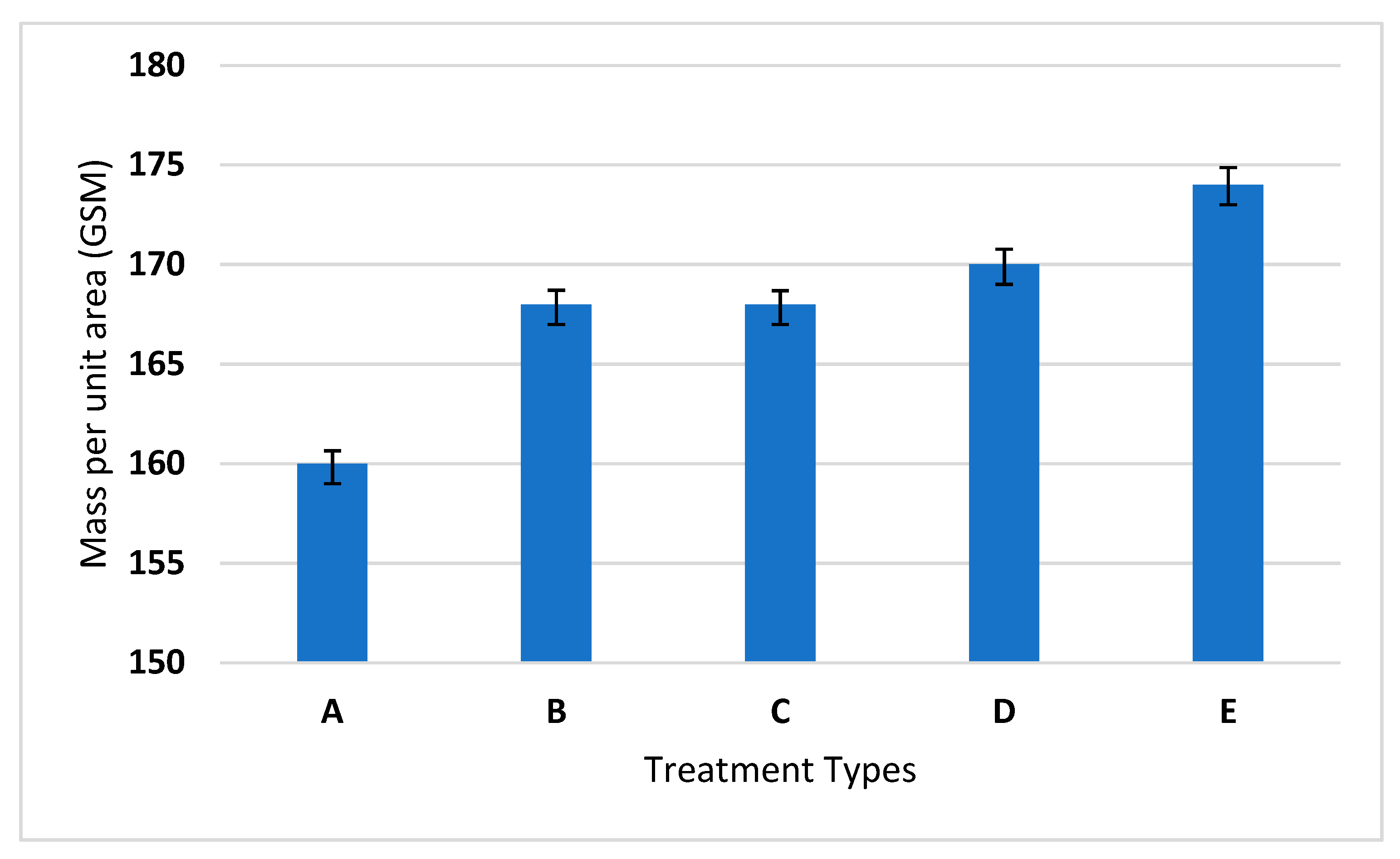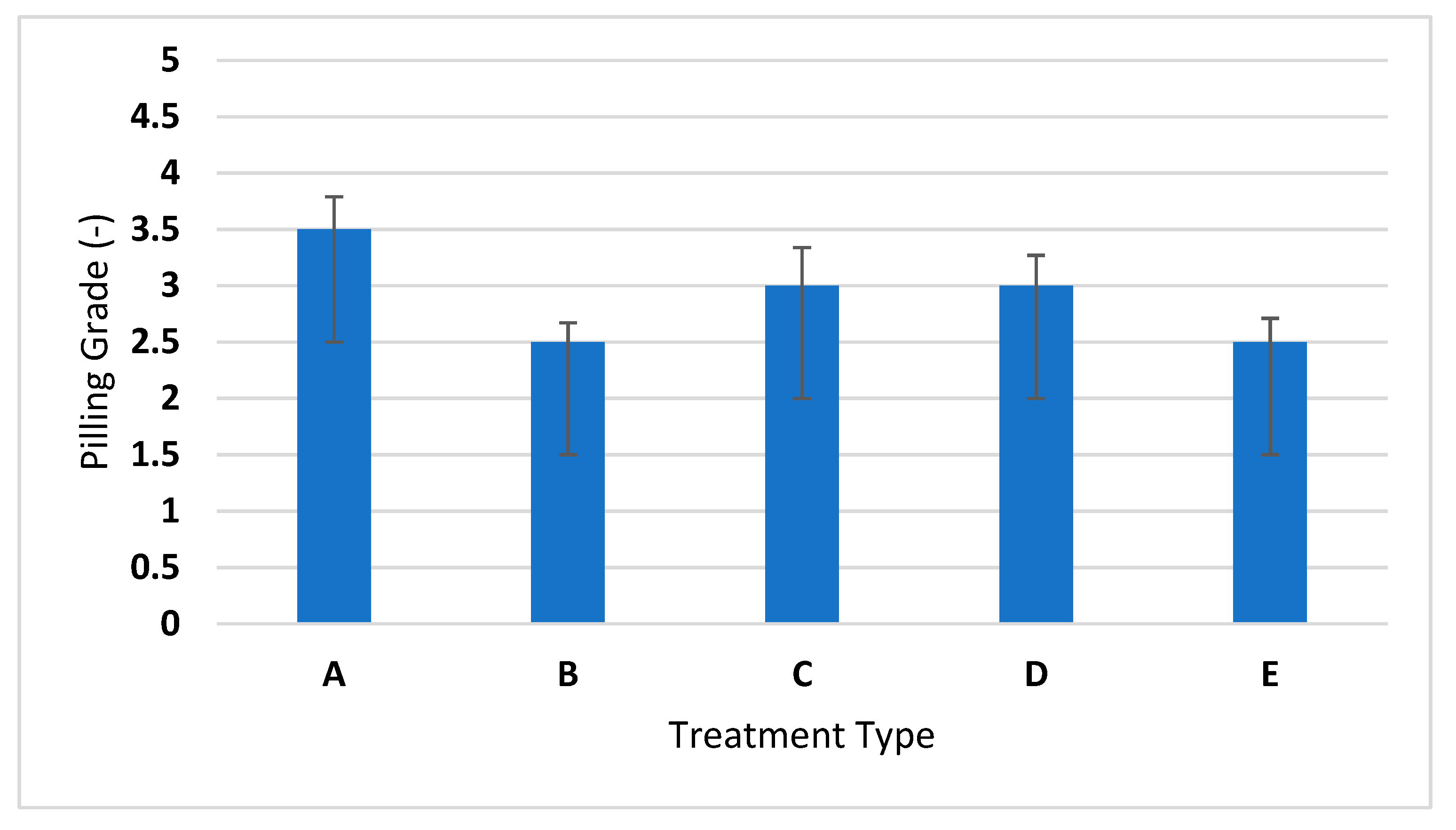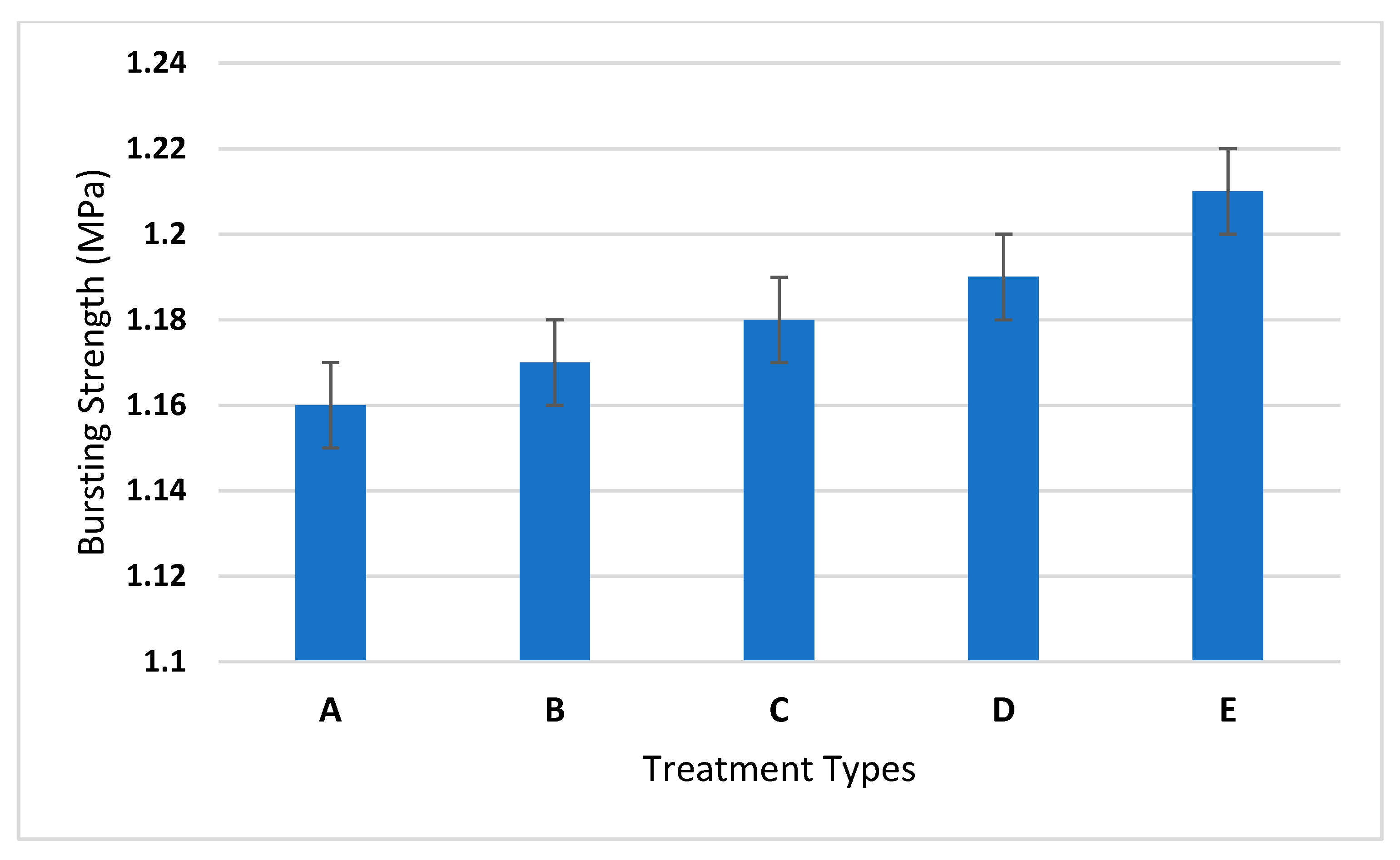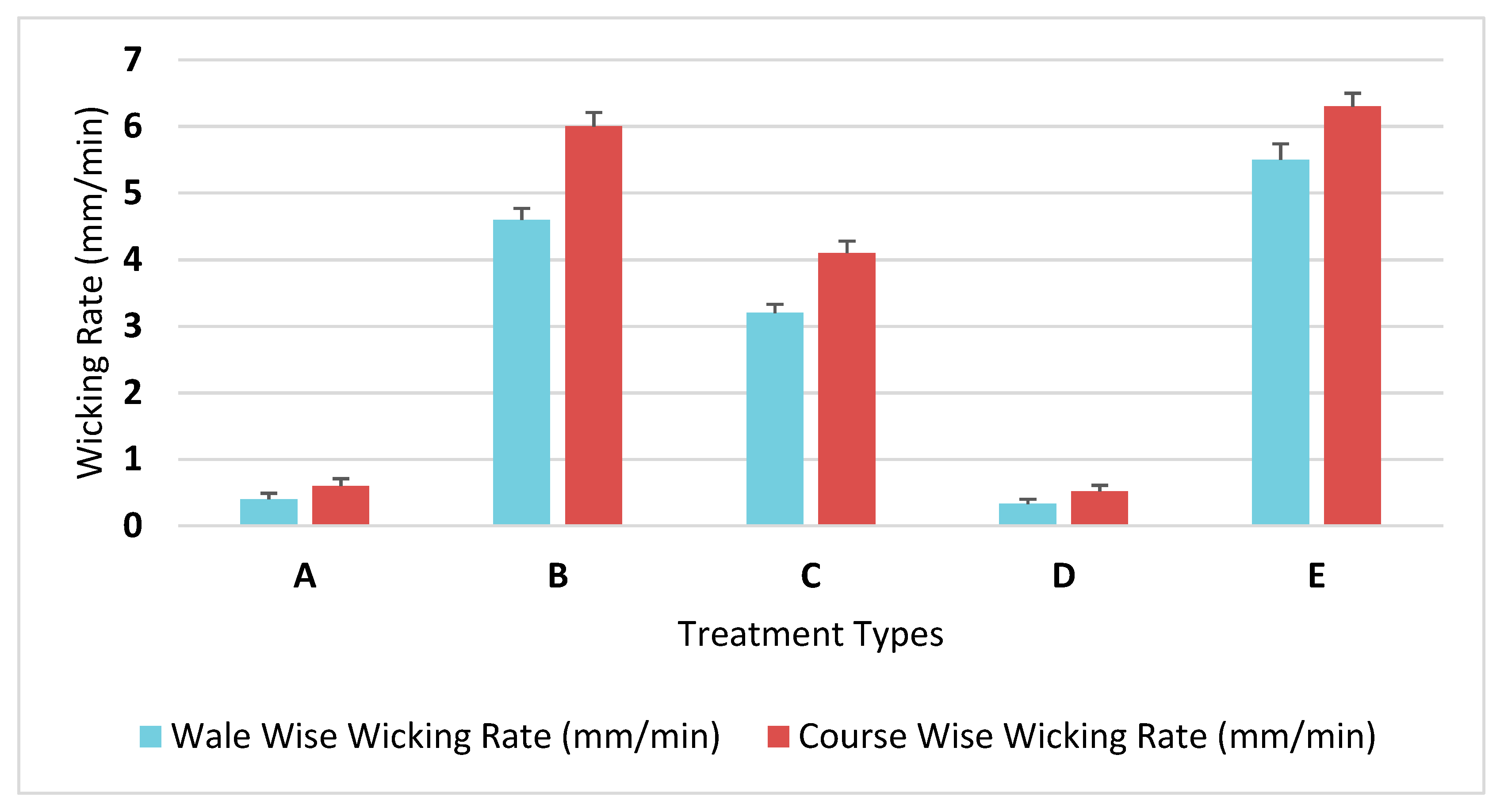The Assessment of Finishing Properties on the Mass per Unit Area, Pilling, Bursting Strength, and Wicking Behavior of Polyester Weft-Knitted Jersey Fabric
Abstract
1. Introduction
2. Materials and Methods
2.1. Mass per Unit Area
2.2. Pilling Test
2.3. Bursting Test
2.4. Vertical Wicking Test
2.5. Yarn Testing
3. Results and Discussion
3.1. Effect of Finishes Treatment on the Mass per Unit Area
3.2. Effect of Finishes Treatment on the Pilling of the Fabric
3.3. Effect of Finishes Treatments on Bursting Strength
3.4. Effect of Finishes Treatments on Wale-Wise and Course-Wise Vertical Wicking
4. Conclusions
Author Contributions
Funding
Acknowledgments
Conflicts of Interest
References
- Chiweshe, A.; Crews, P.C. Influence of household fabric softeners and laundry enzymes on pilling and breaking strength. Text. Chem. Colorist Am. Dyest. Report. 2000, 32, 41–47. [Google Scholar]
- Busilienė, G.; Lekeckas, K.; Urbelis, V. Pilling resistance of knitted fabrics. Mater. Sci. 2011, 17, 297–301. [Google Scholar] [CrossRef]
- Ukponmwan, A.M.J. Pilling. Text. Prog. 2009, 28, 1–57. [Google Scholar] [CrossRef]
- Ukponmwan, J.O.; Mukhopadhyay, A.; Chatterjee, K.N. Pilling. Text. Prog. 1998, 28, 1–57. [Google Scholar] [CrossRef]
- Cooke, W.D. Pilling attrition and fatigue. Text. Res. J. 1985, 55, 409–414. [Google Scholar] [CrossRef]
- Kim, S.; Park, C.K. Evaluation of fabric pilling using hybrid imaging methods. Fibers Polym. 2006, 7, 57. [Google Scholar] [CrossRef]
- Alston, P.V. Effect of Yarn Spinning System on Pill Resistance of Polyester/Cotton Knit Fabrics. Text. Res. J. 1992, 62, 105–108. [Google Scholar] [CrossRef]
- Srinivasan, J.; Ramakrishnan, G.; Mukhopadhyay, S.; Manoharan, S. A study of knitted fabrics from polyester microdenier fibres. J. Text. Inst. 2007, 98, 31–35. [Google Scholar] [CrossRef]
- Tadesse, M.G.; Nagy, L.; Nierstrasz, V.; Loghin, C.; Chen, Y.; Wang, L. Low-Stress Mechanical property study of various functional fabrics for tactile property evaluation. Materials 2018, 11, 2466. [Google Scholar] [CrossRef]
- Milind, M.; Pant, S. Effect of resin finishes on pilling and dimensional stability of knitted fabrics. Man Made Text. India 2014, 42, 9–12. [Google Scholar]
- Doustaneh, A.H.; Mahmoudian, S.; Mohammadian, M.; Jahangir, A. The effects of weave structure and yarn fiber specification on pilling of woven fabrics. World Appl. Sci. J. 2013, 24, 503–506. [Google Scholar]
- Tusief, M.Q.; Mahmood, N.; Amin, N.; Saleem, M. Fabric tensile strength as affected by different anti pilling agents at various concentration and pH levels. J. Chem. Soc. Pak. 2013, 35, 238–242. [Google Scholar]
- Akter Smriti, S.; Azharul Islam, M. An exploration on pilling attitudes of cotton polyester blended single jersey knit fabric after mechanical singeing. Sci. Innov. 2015, 3, 18–21. [Google Scholar] [CrossRef]
- Brand, R.H.; Bohmfalk, B.M. A mathematical model of pilling mechanisms 1. Text. Res. J. 1967, 37, 467–476. [Google Scholar] [CrossRef]
- Akter, N.; Akter, N. Effects of combed and carded yarn on weft knitted finished fabric quality. Int. J. Eng. Technol. IJET-IJENS 2011, 11, 93–97. [Google Scholar]
- Hussain, T.; Safdar, F.; Nazir, A.; Iqbal, K. Optimizing the shrinkage and bursting strength of knitted fabrics after resin finishing. J. Chem. Soc. Pak. 2013, 35, 1452–1456. [Google Scholar]
- Chowdhary, U.; Adnan, M.M.; Cheng, C. Bursting strength and extension for jersey, interlock and pique knits. Trends Text. Eng. Technol. 2018, 1, 19–27. [Google Scholar] [CrossRef][Green Version]
- Demiryürek, O.; Uysaltürk, D. Investigation on bursting strength and pilling properties of viloft/polyester blended knitted fabrics. J. Text. Eng. 2016, 23, 104–111. [Google Scholar]
- Özbayrak, N.; Kavuşturan, Y. The effects of inlay yarn amount and yarn count on extensibility and bursting strength of compression stockings. J. Text. Apparel/Tekst. Konfeksiyon 2009, 19, 102–107. [Google Scholar]
- Gong, R.H.; Bhatia, A. Effects of softeners on mechanical properties of cotton fabric. Res. J. Text. Appar. 2009, 13, 45–50. [Google Scholar] [CrossRef]
- Khandaker, S.; Bhuiyan, M.A.; Hannan, M.A.; Al Faruque, M.A.; Azim, A.Y.M.; Rouf, M.A. Scope of polyester cotton blended single jersey knit fabric finishing without heat setting. Int. J. Sci. Eng. Technol. 2014, 3, 725–729. [Google Scholar]
- Saricam, C. Absorption, wicking and drying characteristics of compression garments. J. Eng. Fibers Fabr. 2015, 10, 146–154. [Google Scholar] [CrossRef]
- Gocek, İ.; Duru, S.C. Investigating the effects of wicking and antibacterial finishing treatments on some comfort characteristics of Meryl skinlife for seamless activewear/sportswear. J. Eng. Fibers Fabr. 2019, 14, 1558925019852790. [Google Scholar] [CrossRef]
- Dong, Y.; Thomas, N.L.; Lu, X. Electrospun dual-layer mats with covalently bonded ZnO nanoparticles for moisture wicking and antibacterial textiles. Mater. Des. 2017, 134, 54–63. [Google Scholar] [CrossRef]
- ASTM D3776 Standard Test Methods for Mass Per Unit Area (Weight) of Fabric; ATSM: West Conshohocken, PA, USA, 2011.
- ASTM D3512 Standard Test Method for Pilling Resistance and Other Related Surface Changes of Textile Fabrics: Random Tumble Pilling Tester Method; ASTM: West Conshohocken, PA, USA, 2005.
- ASTM D3786/D3786M—13 Standard Test Method for Bursting Strength of Textile Fabrics-Diaphragm Bursting Strength Tester Method, D 3786/D3786 M-13; ASTM: West Conshohocken, PA, USA, 2013.
- Kalkanci, M.; Sinecen, M.; Kurumer, G. Prediction of dimensional change in finished fabric through artificial neural networks. Tekst. Konfeksiyon 2018, 28, 43–51. [Google Scholar]
- Harper, R.J., Jr.; Ruppenicker, G., Jr.; Donaldson, D. Cotton blend fabrics from polyester core yarns. Text. Res. J. 1986, 56, 80–86. [Google Scholar] [CrossRef]
- Sharma, I.C.; Mukhopadhyay, D.; Agarwal, B.R. Feasibility of single jersey fabric from open-end spun blended yarn. Text. Res. J. 1986, 56, 249–253. [Google Scholar] [CrossRef]
- Chowdhury, M.A. Improvement of moisture management of polyester fabric using moisture management chemical. Int. J. Eng. Technol. Manag. Appl. Sci. 2018, 5, 70–78. [Google Scholar]
- Cloud, R.M.; Cao, W.; Song, G. Functional finishes to improve the comfort and protection of apparel. In Advances in the Dyeing and Finishing of Technical Textiles; Elsevier: Amsterdam, The Netherlands, 2013; pp. 258–279. [Google Scholar]





| Parameters Name | Specifications |
|---|---|
| Composition | 100% Spun Polyester |
| Wpcm 1 | 12 |
| Cpcm 2 | 17 |
| Stitch Length | 0.295 cm |
| Mass per unit area (Gsm) | 160 |
| Machine Name | Vanguard Supreme |
| Diameter | 18 |
| Gauge | 22 |
| Needles | 1248 |
| RPM 3 | 28 |
| Count Range | 24/1–40/1 |
| Feeders | 18 |
| Linear Density | 1.3 denier |
| Fiber Length | 38 mm |
| Fiber Type | Polyester |
| Yarn Type | Ring-spun yarn |
| Material used | 100% Polyester |
| TPI 4 | 14 |
| Count | 23.7 |
| CLSP 5 | 5794 |
| Color | White |
| Fabric Treatment | Recipe Coding | Chemicals | Quantity (g∙L−1) |
|---|---|---|---|
| Gray Fabric (Untreated Reference Sample) | A | N/A | N/A |
| Simple Wash (For Removing stains and oil marks | B | Felosin RCN | 2 |
| Diavan PCV | 2 | ||
| Normal Finish (For improving fabric hand feel and softness) | C | Acetic acid | 0.11 |
| Polyavin PEN | 0.83 | ||
| Founglube Softener | 0.5 | ||
| Silicon Finish (For improving the softness of the fabric) | D | Acetic acid | 0.11 |
| Polyavin PEN | 0.83 | ||
| Magasil MT | 1 | ||
| Cerofin SMT | 3.3 | ||
| Wicking Finish For Improving the wicking behavior of the fabric | E | Acetic acid | 0.11 |
| Rucofin GSQ 200 | 1.5 | ||
| Reapert SR | 1.5 |
| Treatment Type | Mass per Unit Area (GSM) | SD (±) |
|---|---|---|
| A | 160 | 0.65 |
| B | 168 | 0.71 |
| C | 168 | 0.69 |
| D | 170 | 0.76 |
| E | 174 | 0.86 |
| Treatment Type | Pilling Grade (-) | SD (±) |
|---|---|---|
| A | 3.5 | 0.29 |
| B | 2.5 | 0.17 |
| C | 3 | 0.34 |
| D | 3 | 0.27 |
| E | 2.5 | 0.21 |
| Treatment Type | Bursting Strength (MPa) | SD (±) |
|---|---|---|
| A | 1.16 | 0.020 |
| B | 1.17 | 0.022 |
| C | 1.18 | 0.021 |
| D | 1.19 | 0.024 |
| E | 1.21 | 0.027 |
| Treatment Type | Wale-Wise Wicking Rate (mm·min−1) | SD (±) | Course-Wise Wicking Rate (mm·min−1) | SD (±) |
|---|---|---|---|---|
| A | 0.4 | 0.09 | 0.6 | 0.11 |
| B | 5 | 0.17 | 6.2 | 0.21 |
| C | 3.2 | 0.13 | 4.1 | 0.18 |
| D | 0.33 | 0.21 | 0.52 | 0.25 |
| E | 5.5 | 0.24 | 6.3 | 0.20 |
© 2020 by the authors. Licensee MDPI, Basel, Switzerland. This article is an open access article distributed under the terms and conditions of the Creative Commons Attribution (CC BY) license (http://creativecommons.org/licenses/by/4.0/).
Share and Cite
Hassan, T.; Khan, M.Q.; Salam, A.; Hassan, N.; Raza, A.; Bukhsh, N.; Javed, Z.; Kim, I.S. The Assessment of Finishing Properties on the Mass per Unit Area, Pilling, Bursting Strength, and Wicking Behavior of Polyester Weft-Knitted Jersey Fabric. Coatings 2020, 10, 723. https://doi.org/10.3390/coatings10080723
Hassan T, Khan MQ, Salam A, Hassan N, Raza A, Bukhsh N, Javed Z, Kim IS. The Assessment of Finishing Properties on the Mass per Unit Area, Pilling, Bursting Strength, and Wicking Behavior of Polyester Weft-Knitted Jersey Fabric. Coatings. 2020; 10(8):723. https://doi.org/10.3390/coatings10080723
Chicago/Turabian StyleHassan, Tufail, Muhammad Qamar Khan, Abdul Salam, Nafees Hassan, Ali Raza, Nabi Bukhsh, Zafar Javed, and Ick Soo Kim. 2020. "The Assessment of Finishing Properties on the Mass per Unit Area, Pilling, Bursting Strength, and Wicking Behavior of Polyester Weft-Knitted Jersey Fabric" Coatings 10, no. 8: 723. https://doi.org/10.3390/coatings10080723
APA StyleHassan, T., Khan, M. Q., Salam, A., Hassan, N., Raza, A., Bukhsh, N., Javed, Z., & Kim, I. S. (2020). The Assessment of Finishing Properties on the Mass per Unit Area, Pilling, Bursting Strength, and Wicking Behavior of Polyester Weft-Knitted Jersey Fabric. Coatings, 10(8), 723. https://doi.org/10.3390/coatings10080723







